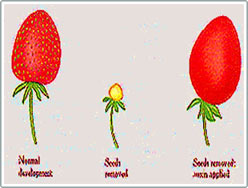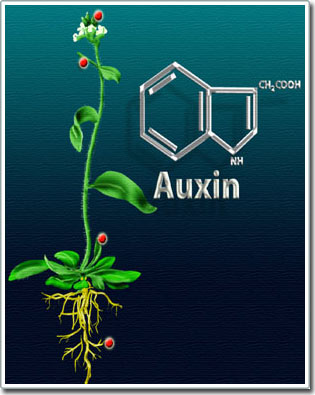From auxin growth stimulant to herbicide
In nature, auxin is the hormone that helps plants grow. However, when synthesized into other substances, including herbicides, auxin can be harmful to humans.
Auxin: Growth stimulants

Compare fruits in nature (left) with fruits treated with growth stimulants (right). (Photo: Plant-hormones.info)
' Auxin ' growth stimulant comes from the Greek language - auxein, meaning growth.
Typically, compounds are called auxin if they are capable of stimulating plant cells to grow, on the other hand, their nature is similar to indoleacetic acid (the first isolated growth stimulant) on physiological face.
Auxin is the first plant growth hormone discovered by humans. Charles Darwin was one of the first scientists to pursue research on it. Most of our current knowledge of growth stimulants is based on its application.
Auxin is a group of regulators that regulate the growth of plants common in nature. In small amounts, A has a stimulating effect on growth, but in large quantities has a repressive effect.
Among the typical substances, đến - indolylaxetic (IAA) acid, α - naphthylaxetic acid must be included. Auxins are formed continuously in the growth peaks of stems and roots. Auxin regulates the rate of cell expansion in the growth area of the stem tip and is related to the bending reaction in light and soil orientation.
Auxin stimulates the growth of pollen tubes and its products during seed growth, stimulating the development of fruits and pods in fruit flesh. Auxin inhibits the growth of lateral shoots, which assists with gibberellin and caffeine in cell division and differentiation of strata. Auxin counteracts abxisic acid in deciduous phenomenon.

Auxins are formed continuously in the growth tops of stems and roots . (Photo: nsf.gov)
From auxin to herbicides
Synthetic growth stimulants started the era of organic herbicides. In the 1940s, these drugs came into being after a long-term research program of growth plant stimulants - auxin.
Auxin has been synthesized for widespread use in agriculture: NAA (naphthyletic acid) is used as a root hormone and germinated; 2, 4 D used to kill grass and change the development of fruits; 2,4,5- T (Trichlorophenoxyacetic acid) is a herbicide.
2,4-D is an auxin-based herbicide, a widespread herbicide. Currently, mainly 2,4-D is used in blends mixed with other herbicides, with shoulders. As an effect enhancer. It is widely used all over the world. In the United States alone, 2,4-D is the third most common herbicide.
2,4,5-Trichlorophenoxyacetic acid (2,4,5-T) is a widely used herbicide until it was gradually withdrawn from the market in the late 1970s. 4,5-T is just a substance with moderate toxicity. The amount of oral toxicity that can be toxic to rats is 389 mg / kg weight. However, the production of 2,4,5-T produced an amount of 2,3,7,8-tetrachlorodibenzo-p-dioxin (TCDD).
TCDD is really extremely toxic to humans. At an appropriate temperature, the production of 2,4,5-T can produce 0.005 ppm TCDD. Many individual tests later showed that many batches, TCDD content up to 60 ppm.
2,4,5-T was banned from circulation in the United States in 1983, which was at a time when the community was extremely sensitive to chemical hazards in the environment. The community is more concerned about dioxin. Products and other chemicals that are not herbicides, potentially containing TCDD toxic substances, were withdrawn from the market in turn.
Furthermore, the mixture of 2,4,5-T, 2,4-D, and picloram produced Agent Orange - Agent Orange. Agent Orange is used by the US military in Vietnam from January 1965 and April 1970 as a defoliant. Because TCDD was one of the components of 2,4,5-T, it was accused of causing many serious illnesses for those involved in the war.

Chemical formula of a typical growth stimulant β - indolylaxetic acid (IAA) (Photo: ulg.ac.be)
Hát (General: plant-hormones.info, encyclopedia, answers.com, wikipedia, VNN)
- Detection of growth stimulant inhibitors
- Cucumbers contain growth hormone
- How dangerous is herbicide poisoning Paraquat?
- 'Strange disease' Is killing in Nigeria a herbicide?
- Detection of fungal herbicides 6 times stronger than Glyphosate
- Strange watermelon explodes right in the field
- Scary of drugs 'tongue talismans' that make you suffer from schizophrenia for life
- Cooperation on green growth for sustainable development
- Li explained the phenomenon of watermelon suddenly exploded
- Growth hormone enhances memory
- Determine GDP growth rate from outer space
- China focuses on green growth
 Why do potatoes have eyes?
Why do potatoes have eyes? 'Tragedy' the world's largest carnivorous life: Death becomes ... public toilet
'Tragedy' the world's largest carnivorous life: Death becomes ... public toilet Tomatoes were once considered 'poisonous' for 200 years
Tomatoes were once considered 'poisonous' for 200 years Detecting microscopic parasites on human face
Detecting microscopic parasites on human face